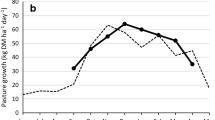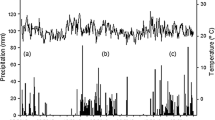Abstract
Emissions of N2O from two dairy farms with different grazing intensity responded non-linearly to increasing soil nitrate availability and total rainfall. Higher N2O emissions were observed immediately after grazing, due to the possible increased incidence of N deposition from animal excreta, increased soil compaction and low plant N uptake. The spatial distribution of N2O fluxes and soil nitrate contents reflected the effect of animal treading and excreta N deposition with N2O fluxes in the proximity of field gateways 11 times higher than the field average. Three years average annual N2O emissions were 6 times higher (9.3 ± 2.6 kg N2O-N ha−1 y−1) in the high grazing intensity farm than in the low grazing intensity farm (1.6 ± 0.2 kg N2O-N ha−1 y−1). This corresponded to 2% and 0.9% of the fertiliser N inputs lost as N2O for the high and low intensity farm, respectively. The GHG intensity (N2O emitted per kg of fat and protein corrected milk FPCM) for the intensive system was only almost two times higher than the non-intensive system (0.12 vs 0.08 kg CO2-eq per kg FPCM y−1 for the high and low intensity system, respectively). The high occurrence of N load hotspots near animal gateways in this study underlines the necessity to account for the spatial N variation in dairy grazing systems. Integrating the spatial management of N loads into improved farming practice has therefore significant scope to reduce N2O emissions and N losses from dairy grazing systems.






Similar content being viewed by others
References
Akaike H (1974) A new look at the statistical model identification. IEEE Trans Autom Control 19:716–723. https://doi.org/10.1109/TAC.1974.1100705
Basso B, Ritchie JT (2015) Simulating crop growth and biogeochemical fluxes in response to land management using the SALUS model. In: Hamilton SK, Doll JE, Robertson GP (eds) The ecology of agricultural landscapes: long-term research on the path to sustainability. Oxford University Press, New York, pp 252–274
Clough TJ, Lanigan GJ, de Klein CAM, Samad MS, Morales SE, Rex D, Bakken LR, Johns C, Condron LM, Grant J, Richards KG (2017) Influence of soil moisture on codenitrification fluxes from a urea-affected pasture soil. Sci Rep 7:2185. https://doi.org/10.1038/s41598-017-02278-y
Commonwealth of Australia (2014) National Inventory Report 2012 Volume 1
Commonwealth of Australia (2017) National Inventory Report 2015 Volume 1
Eugster W, Merbold L (2015) Eddy covariance for quantifying trace gas fluxes from soils. Soil 1:187–205. https://doi.org/10.5194/soil-1-187-2015
FAO (1998) World reference base for soil resources. World soil resources reports 84. Food and Agriculture Organization of the United Nations
Friedl J, Scheer C, Rowlings DW, McIntosh HV, Strazzabosco A, Warner DI, Grace PR (2016) Denitrification losses from an intensively managed sub-tropical pasture—impact of soil moisture on the partitioning of N2 and N2O emissions. Soil Biol Biochem 92:58–66. https://doi.org/10.1016/j.soilbio.2015.09.016
Friedl J, Scheer C, Rowlings DW, Mumford MT, Grace PR (2017) The nitrification inhibitor DMPP (3,4-dimethylpyrazole phosphate) reduces N2 emissions from intensively managed pastures in subtropical Australia. Soil Biol Biochem 108:55–64. https://doi.org/10.1016/j.soilbio.2017.01.016
Gerber P, Vellinga T, Opio C, Steinfeld H (2011) Productivity gains and greenhouse gas emissions intensity in dairy systems. Livest Sci 139:100–108. https://doi.org/10.1016/j.livsci.2011.03.012
Grace P, Shcherbak I, Macdonald B, Scheer C, Rowlings D (2016) Emission factors for estimating fertiliser-induced nitrous oxide emissions from clay soils in Australia’s irrigated cotton industry. Soil Res 54:598–603. https://doi.org/10.1071/SR16091
Hamonts K, Balaine N, Moltchanova E, Beare M, Thomas S, Wakelin SA, O’Callaghan M, Condron LM, Clough TJ (2013) Influence of soil bulk density and matric potential on microbial dynamics, inorganic N transformations, N2O and N2 fluxes following urea deposition. Soil Biol Biochem 65:1–11. https://doi.org/10.1016/j.soilbio.2013.05.006
Haynes RJ, Williams PH (1993) Nutrient cycling and soil fertility in the grazed pasture ecosystem. In: Sparks DL (ed) Advances in agronomy. Academic Press, Cambridge, pp 119–199. https://doi.org/10.1016/S0065-2113(08)60794-4
Henry B, Eckard R (2009) Greenhouse gas emissions in livestock production systems. Trop Grassl 43:232–238
Hyde BP, Hawkins MJ, Fanning AF, Noonan D, Ryan M, O’ Toole P, Carton OT (2006) Nitrous oxide emissions from a fertilized and grazed grassland in the South East of Ireland. Nutr Cycl Agroecosyst 75:187–200. https://doi.org/10.1007/s10705-006-9026-x
Jayasundara S, Wagner-Riddle C (2013) Greenhouse gas emissions intensity of Ontario milk production in 2011 compared with 1991. Can J Anim Sci 94:155–173. https://doi.org/10.4141/cjas2013-127
Keating BA, Carberry PS, Hammer GL, Probert ME, Robertson MJ, Holzworth D, Huth NI, Hargreaves JNG, Meinke H, Hochman Z, McLean G, Verburg K, Snow V, Dimes JP, Silburn M, Wang E, Brown S, Bristow KL, Asseng S, Chapman S, McCown RL, Freebairn DM, Smith CJ (2003) An overview of APSIM, a model designed for farming systems simulation. Eur J Agron 18:267–288. https://doi.org/10.1016/S1161-0301(02)00108-9
Krivoruchko K, Gribov A (2014) Pragmatic Bayesian kriging for non-stationary and moderately non-Gaussian data. Springer, Berlin, pp 61–64
Kroeze C, Mosier A, Nevison C, Oenema O, Seitzinger S, van Cleemput O, Conrad R, Mitra A, Hu N, Sass R (1997) Revised 1996 IPCC Guidelines for National Greenhouse Gas Inventories. IPCC/OECD/IEA. Paris, pp 1–140. http://www.ipcc-nggip.iges.or.jp/public/gl/invs1.html. Accessed May 2019
Liang LL, Campbell DI, Wall AM, Schipper LA (2018) Nitrous oxide fluxes determined by continuous eddy covariance measurements from intensively grazed pastures: temporal patterns and environmental controls. Agric Ecosyst Environ 268:171–180. https://doi.org/10.1016/j.agee.2018.09.010
Luo J, Ledgard SF, Lindsey SB (2008) A test of a winter farm management option for mitigating nitrous oxide emissions from a dairy farm. Soil Use Manag 24:121–130. https://doi.org/10.1111/j.1475-2743.2007.00140.x
Luo J, de Klein CAM, Ledgard SF, Saggar S (2010) Management options to reduce nitrous oxide emissions from intensively grazed pastures: a review. Agric Ecosyst Environ 136:282–291. https://doi.org/10.1016/j.agee.2009.12.003
Luo J, Ledgard SF, Lindsey SB (2013) Nitrous oxide and greenhouse gas emissions from grazed pastures as affected by use of nitrification inhibitor and restricted grazing regime. Sci Total Environ 465:107–114. https://doi.org/10.1016/j.scitotenv.2012.12.075
Luo J, Wyatt J, van der Weerden TJ, Thomas SM, de Klein CAM, Li Y, Rollo M, Lindsey S, Ledgard SF, Li J, Ding W, Qin S, Zhang N, Bolan N, Kirkham MB, Bai Z, Ma L, Zhang X, Wang H, Liu H, Rys G (2017) Chapter five—potential hotspot areas of nitrous oxide emissions from grazed pastoral dairy farm systems. In: Sparks DL (ed) Advances in agronomy. Academic Press, Cambridge, pp 205–268. https://doi.org/10.1016/bs.agron.2017.05.006
Marsden KA, Holmberg JA, Jones DL, Chadwick DR (2018) Sheep urine patch N2O emissions are lower from extensively-managed than intensively-managed grasslands. Agric. Ecosyst Environ 265:264–274. https://doi.org/10.1016/j.agee.2018.06.025
Menneer JC, Ledgard S, McLay C, Silvester W (2005) Animal treading stimulates denitrification in soil under pasture. Soil Biol Biochem 37:1625–1629. https://doi.org/10.1016/j.soilbio.2005.01.023
Moir JL, Cameron KC, Di HJ, Fertsak U (2011) The spatial coverage of dairy cattle urine patches in an intensively grazed pasture system. J Agric Sci 149:473–485. https://doi.org/10.1017/S0021859610001012
Mumford MT, Rowlings DW, Scheer C, De Rosa D, Grace PR (2019) Effect of irrigation scheduling on nitrous oxide emissions in intensively managed pastures. Agric Ecosyst Environ 272:126–134. https://doi.org/10.1016/j.agee.2018.11.011
Pilz J, Spöck G (2008) Why do we need and how should we implement Bayesian kriging methods. Stoch Environ Res Risk Assess 22:621–632. https://doi.org/10.1007/s00477-007-0165-7
R Core Team (2020) R: A language and environment for statistical computing. R Foundation for Statistical Computing, Vienna
Rafique R, Hennessy D, Kiely G (2011) Nitrous oxide emission from grazed grassland under different management systems. Ecosystems 14:563–582. https://doi.org/10.1007/s10021-011-9434-x
Rowlings DW, Grace PR, Scheer C, Liu S (2015) Rainfall variability drives interannual variation in N2O emissions from a humid, subtropical pasture. Sci Total Environ 512–513:8–18. https://doi.org/10.1016/j.scitotenv.2015.01.011
Saggar S, Hedley CB, Giltrap DL, Lambie SM (2007) Measured and modelled estimates of nitrous oxide emission and methane consumption from a sheep-grazed pasture. Agric Ecosyst Environ 122:357–365. https://doi.org/10.1016/j.agee.2007.02.006
Saggar S, Jha N, Deslippe J, Bolan NS, Luo J, Giltrap DL, Kim DG, Zaman M, Tillman RW (2013) Denitrification and N2O:N2 production in temperate grasslands: Processes, measurements, modelling and mitigating negative impacts. Sci Total Environ 465:173–195. https://doi.org/10.1016/j.scitotenv.2012.11.050
Scheer C, Grace PR, Rowlings DW, Payero JJP (2012) Nitrous oxide emissions from irrigated wheat in Australia: impact of irrigation management. Plant Soil 359:351–362. https://doi.org/10.1007/s11104-012-1197-4
Scheer C, Rowlings DW, Firrel M, Deuter P, Morris S, Grace PR (2014) Impact of nitrification inhibitor (DMPP) on soil nitrous oxide emissions from an intensive broccoli production system in sub-tropical Australia. Soil Biol Biochem 77:243–251. https://doi.org/10.1016/j.soilbio.2014.07.006
Scheer C, Rowlings D, Firrell M, Deuter P, Morris S, Riches D, Porter I, Grace P (2017) Nitrification inhibitors can increase post-harvest nitrous oxide emissions in an intensive vegetable production system. Sci Rep 7:43677. https://doi.org/10.1038/srep43677
Selbie DR, Lanigan GJ, Laughlin RJ, Di HJ, Moir JL, Cameron KC, Clough TJ, Watson CJ, Grant J, Somers C, Richards KG (2015) Confirmation of co-denitrification in grazed grassland. Sci Rep 5:17361. https://doi.org/10.1038/srep17361
Shcherbak I, Philip Robertson G (2014) Determining the diffusivity of nitrous oxide in soil using in situ tracers. Soil Sci Soc Am J 78:79–88. https://doi.org/10.2136/sssaj2013.05.0181
Shcherbak I, Millar N, Robertson GP (2014) Global metaanalysis of the nonlinear response of soil nitrous oxide (N2O) emissions to fertilizer nitrogen. Proc Natl Acad Sci 111:9199–9204. https://doi.org/10.1073/pnas.1322434111
Smith P, Martino D, Cai Z, Gwary D, Janzen H, Kumar P, McCarl B, Ogle S, O’Mara F, Rice C, Scholes B, Sirotenko O (2007) Agriculture. In: Metz B, Davidson OR, Bosch PR, Dave R, Meyer LA (eds) Climate change 2007: mitigation. Contribution of Working Group III to the fourth assessment report of the intergovernmental panel on climate change. Cambridge University Press, Cambridge, pp 497–540
Tiedje JM (1988) Ecology of denitrification and dissimilatory nitrate reduction to ammonium. Biol Anaerob Microorg 717:179–244
Turner DA, Chen D, Galbally IE, Leuning R, Edis RB, Li Y, Kelly K, Phillips F (2008) Spatial variability of nitrous oxide emissions from an Australian irrigated dairy pasture. Plant Soil 309:77–88. https://doi.org/10.1007/s11104-008-9639-8
van Groenigen JW, Velthof GL, Oenema O, van Groenigen KJ, van Kessel C (2010) Towards an agronomic assessment of N2O emissions: a case study for arable crops. Eur J Soil Sci 61:903–913. https://doi.org/10.1111/j.1365-2389.2009.01217.x
Voglmeier K, Six J, Jocher M, Ammann C (2019) Grazing-related nitrous oxide emissions: from patch scale to field scale. Biogeosciences 16:1685–1703. https://doi.org/10.5194/bg-16-1685-2019
Wecking AR, Wall AM, Liáng LL, Lindsey SB, Luo J, Campbell DI, Schipper LA (2020) Reconciling annual nitrous oxide emissions of an intensively grazed dairy pasture determined by eddy covariance and emission factors. Agric Ecosyst Environ 287:106646. https://doi.org/10.1016/j.agee.2019.106646
Willem van Groenigen J, Velthof GL, Bolt FJEvd, Vos A, Kuikman PJ (2005) Seasonal variation in N2O emissions from urine patches: effects of urine concentration, soil compaction and dung. Plant Soil 273:15–27. https://doi.org/10.1007/s11104-004-6261-2
Wood SN (2015) Package ‘mgcv’. http://cran.r-project.org/web/packages/mgcv/mgcv.pdf
Acknowledgements
The authors would like to thank the Clarke and Undery families for their assistance and access to their farms. Some of the data reported in this paper were obtained at the Central Analytical Research Facility operated by the Institute for Future Environments (QUT). This project was funded by the Australian Department of Agriculture and Water Resources through their Carbon Farming Futures program (AOTGR2-0135).
Author information
Authors and Affiliations
Corresponding author
Additional information
Publisher's Note
Springer Nature remains neutral with regard to jurisdictional claims in published maps and institutional affiliations.
Electronic supplementary material
Below is the link to the electronic supplementary material.
Rights and permissions
About this article
Cite this article
De Rosa, D., Rowlings, D.W., Fulkerson, B. et al. Field-scale management and environmental drivers of N2O emissions from pasture-based dairy systems. Nutr Cycl Agroecosyst 117, 299–315 (2020). https://doi.org/10.1007/s10705-020-10069-7
Received:
Accepted:
Published:
Issue Date:
DOI: https://doi.org/10.1007/s10705-020-10069-7




